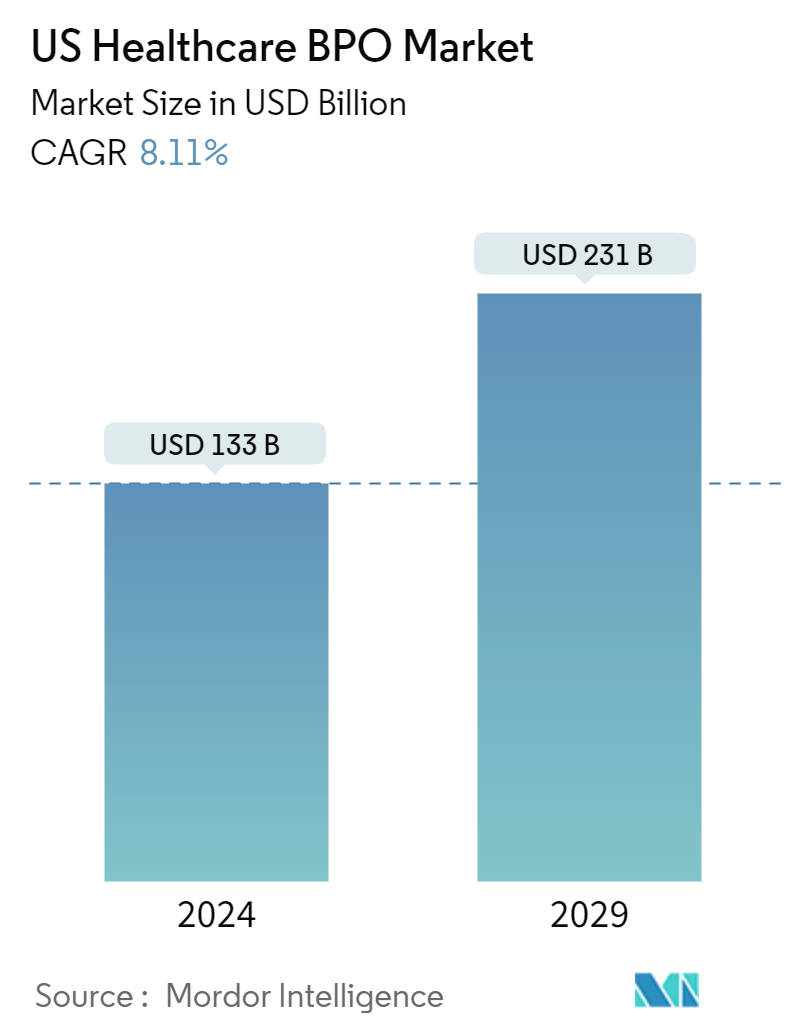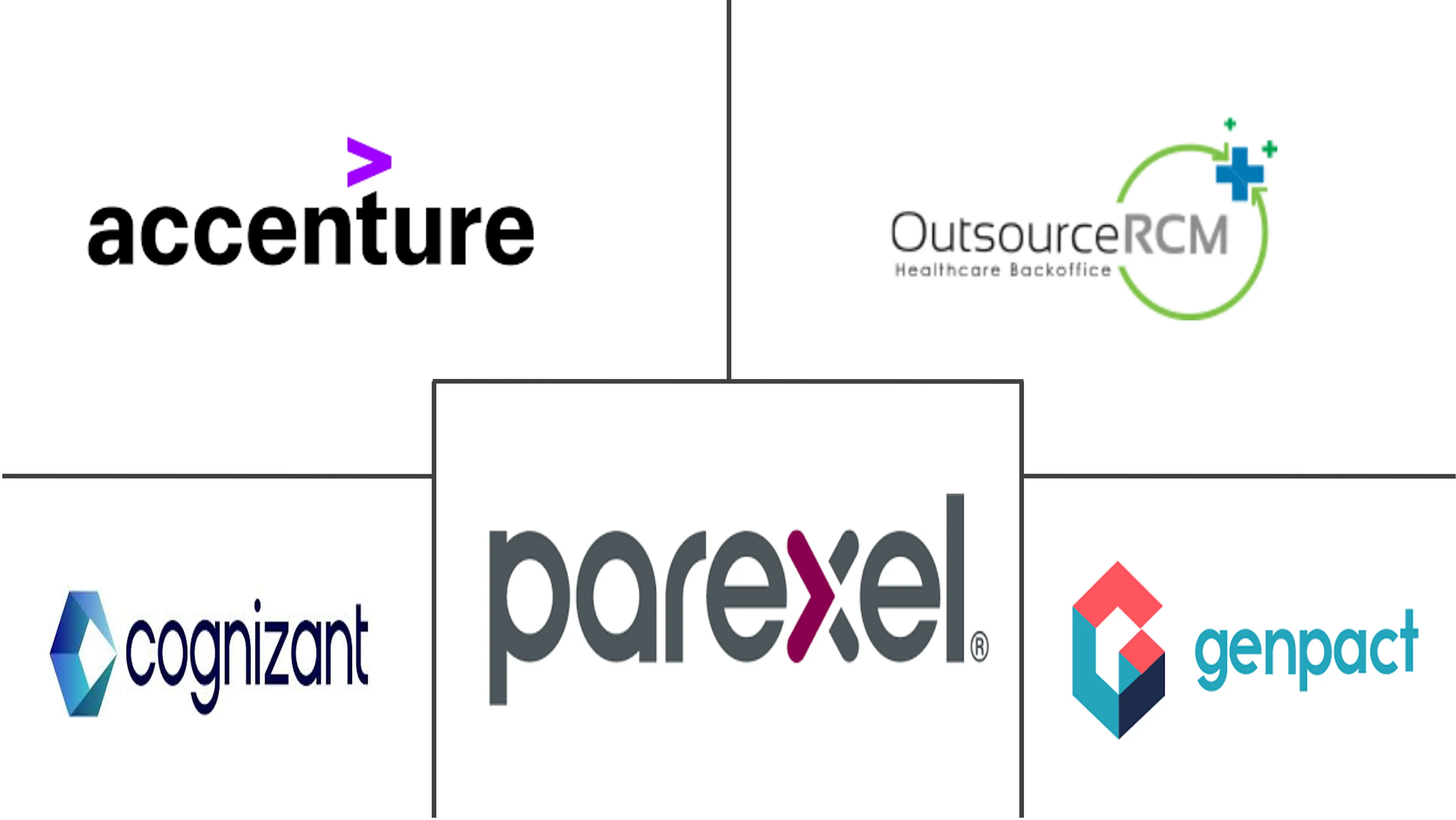Market Size of US Healthcare BPO Industry

| Study Period | 2019 - 2029 |
| Base Year For Estimation | 2023 |
| Market Size (2024) | USD 133 Billion |
| Market Size (2029) | USD 231 Billion |
| CAGR (2024 - 2029) | 8.11 % |
| Market Concentration | Low |
Major Players
*Disclaimer: Major Players sorted in no particular order |
US Healthcare BPO Market Analysis
The US Healthcare BPO Market size is estimated at USD 133 billion in 2024, and is expected to reach USD 231 billion by 2029, growing at a CAGR of 8.11% during the forecast period (2024-2029).
The US healthcare system favors new opportunities and growth due to the quick adoption of advanced technologies among pharmacies, pharmaceutical companies, medical equipment manufacturers, and medical care facilities. The infrastructure of this industry depends on specialized professionals who manage the operations. The expansion of the US healthcare BPO market can be attributed to the heightened awareness of outsourcing healthcare IT services and the significant presence of leading market players in the country.
Another key driving factor is the increasing strategic actions of leading firms, including product launches, alliances, and other actions, which are expected to drive market expansion throughout the forecast period. For example, in December 2023, Acquire BPO expanded its geographical presence in Texas, United States, to address the increasing demand for outsourcing solutions. The opening of the Irving headquarters reinforces the company's position as a significant player in the US market, enabling improved collaborations with clients. In March 2022, CPSI, a company specializing in healthcare solutions, acquired Healthcare Resource Group Inc. in Spokane, Washington. HRG is a prominent provider of tailored revenue cycle management (RCM) solutions and consulting services that help hospitals and clinics enhance efficiency, profitability, and patient satisfaction.
The increase in government initiatives within the country is expected to propel market growth. For instance, in February 2022, the Department of Health and Human Services (HHS) allocated nearly USD 55 million to 29 health centers funded by the HRSA to enhance healthcare access and quality for underserved populations via virtual care. Virtual care has significantly transformed the patient experience, particularly during the COVID-19 pandemic. Thus, initiatives by government organizations are anticipated to propel market growth across the country.
Moreover, the rising demand for insurance, the need to reduce healthcare delivery expenses, the consolidation of the healthcare system, pharmaceutical companies encountering patent expirations, and the compulsory adoption of ICD-10 codes (the 10th revision of the International Statistical Classification of Diseases and Related Health Problems) are significant drivers behind the expansion of the healthcare BPO market in the United States.
Thus, the market is expected to grow in the United States due to the abovementioned factors, including various government initiatives and strategic actions by market players. However, data integrity and confidentiality may restrain market growth.
US Healthcare BPO Industry Analysis
Healthcare BPO (business process outsourcing) refers to a process in which healthcare providers select the most suited third-party vendors for specific business processes. This allows hospitals and medical professionals to spend their energy and valuable time on patient care.
As per the scope of the report, the US healthcare BPO market is segmented by payer service, provider service, and pharmaceutical service. By payer service, the market is segmented into human resource management, claims management, customer relationship management (CRM), operational/administrative management, care management, provider management, and other payer services. By provider service, the market is segmented into patient enrollment and strategic planning, patient care service, and revenue cycle management. By pharmaceutical service, the market is segmented into research and development, manufacturing, and non-clinical service). For each segment, the market size is provided in terms of value in USD.
| By Payer Service | |
| Human Resource Management | |
| Claims Management | |
| Customer Relationship Management (CRM) | |
| Operational/Administrative Management | |
| Care Management | |
| Provider Management | |
| Other Payer Services |
| By Provider Service | |
| Patient Enrollment and Strategic Planning | |
| Patient Care Service | |
| Revenue Cycle Management |
| By Pharmaceutical Service | |||||
| Research and Development | |||||
| Manufacturing | |||||
|
US Healthcare BPO Market Size Summary
The United States healthcare BPO market is poised for significant growth, driven by the rapid adoption of advanced technologies and the increasing demand for efficient healthcare solutions. The market is characterized by a strong presence of major players and a high level of awareness regarding outsourcing healthcare IT services. Strategic actions by leading firms, such as acquisitions and expansions, are further propelling market growth. Government initiatives aimed at enhancing healthcare access and quality, particularly through virtual care, are also contributing to the market's expansion. The market's growth is supported by factors such as the rising number of individuals seeking insurance, the need to reduce healthcare delivery costs, and the consolidation of the healthcare system.
The market is fragmented, with both large and small-scale players competing for market share. Key segments driving growth include claims processing outsourcing, revenue cycle management, and medical claims management, which are becoming increasingly popular as organizations seek to minimize costs and improve service quality. The growing burden of chronic diseases and the aging population are significant factors driving the demand for these services. Additionally, strategic partnerships and collaborations among market players are expected to further boost segment growth. Despite the promising outlook, challenges such as data integrity and confidentiality concerns may pose potential restraints to market expansion.
US Healthcare BPO Market Size - Table of Contents
-
1. MARKET DYNAMICS
-
1.1 Market Overview
-
1.2 Market Drivers
-
1.2.1 Rapid Increase in Clinical Process Outsourcing (CPO)
-
1.2.2 Increasing R&D in the Healthcare Industry
-
-
1.3 Market Restraints
-
1.3.1 Data Integrity and Confidentiality
-
-
1.4 Porter's Five Forces Analysis
-
1.4.1 Threat of New Entrants
-
1.4.2 Bargaining Power of Buyers/Consumers
-
1.4.3 Bargaining Power of Suppliers
-
1.4.4 Threat of Substitute Products
-
1.4.5 Intensity of Competitive Rivalry
-
-
-
2. MARKET SEGMENTATION (Market Size by Value - USD)
-
2.1 By Payer Service
-
2.1.1 Human Resource Management
-
2.1.2 Claims Management
-
2.1.3 Customer Relationship Management (CRM)
-
2.1.4 Operational/Administrative Management
-
2.1.5 Care Management
-
2.1.6 Provider Management
-
2.1.7 Other Payer Services
-
-
2.2 By Provider Service
-
2.2.1 Patient Enrollment and Strategic Planning
-
2.2.2 Patient Care Service
-
2.2.3 Revenue Cycle Management
-
-
2.3 By Pharmaceutical Service
-
2.3.1 Research and Development
-
2.3.2 Manufacturing
-
2.3.3 Non-clinical Services
-
2.3.3.1 Supply Chain Management and Logistics
-
2.3.3.2 Sales and Marketing Services
-
2.3.3.3 Other Non-clinical Services
-
-
-
US Healthcare BPO Market Size FAQs
How big is the US Healthcare BPO Market?
The US Healthcare BPO Market size is expected to reach USD 133 billion in 2024 and grow at a CAGR of 8.11% to reach USD 231 billion by 2029.
What is the current US Healthcare BPO Market size?
In 2024, the US Healthcare BPO Market size is expected to reach USD 133 billion.

